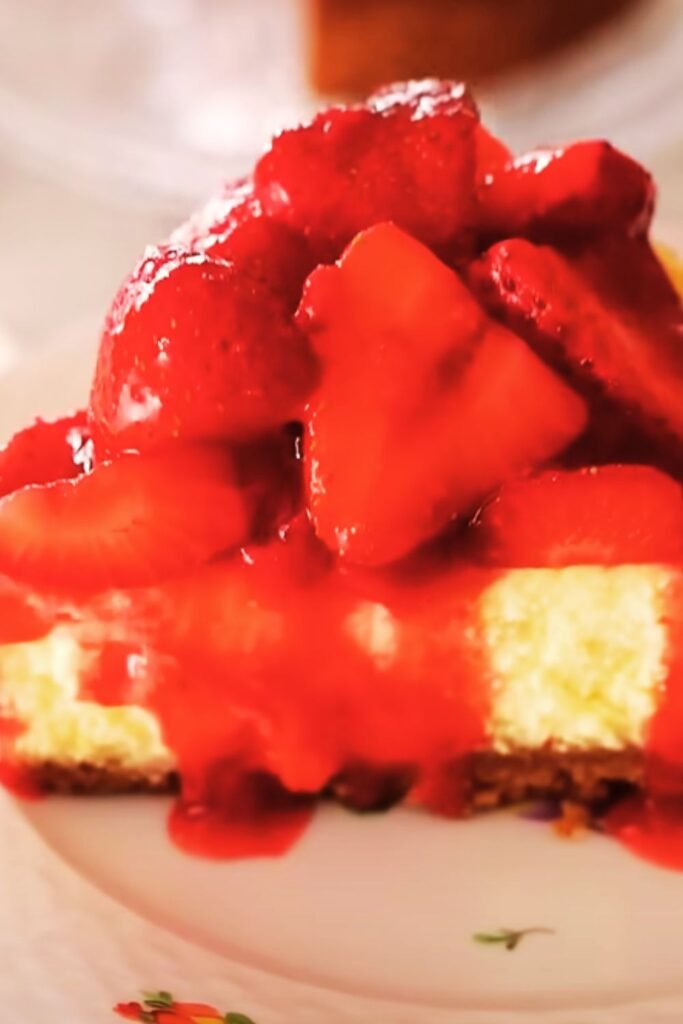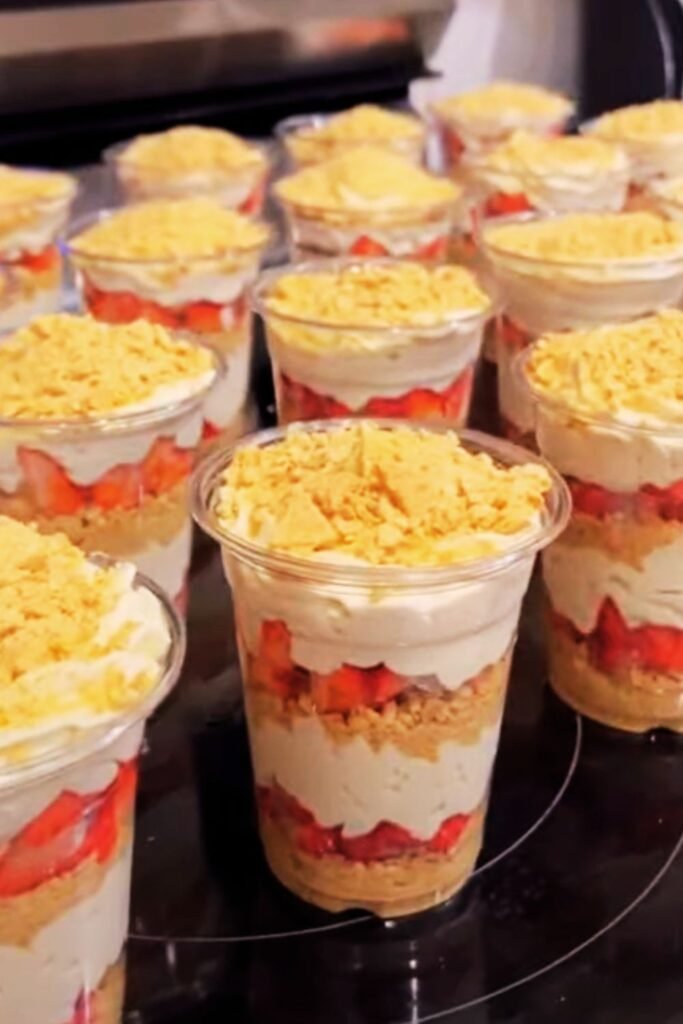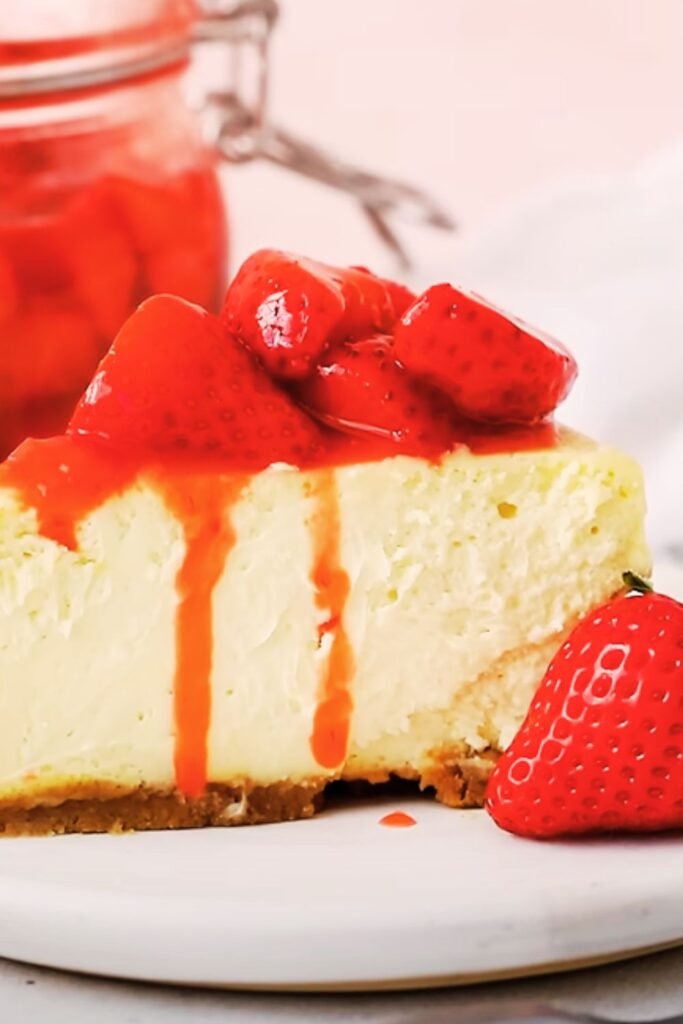There’s something magical about the perfect strawberry cheesecake that makes time stand still. That first bite—where the creamy cheese filling meets the sweet-tart strawberry topping and crumbly graham cracker crust—creates a moment of pure bliss. I’ve spent years perfecting my strawberry cheesecake recipe, and today I’m sharing all my secrets with you.
A Love Affair with Strawberry Cheesecake
My journey with strawberry cheesecake began in my grandmother’s kitchen. I remember watching her hands move with practiced precision as she pressed graham cracker crumbs into the pan, whipped cream cheese until light and fluffy, and arranged fresh strawberries in concentric circles on top. The anticipation of waiting for that cheesecake to chill was nearly unbearable, but the reward was always worth it.
Now, decades later, I’ve taken her traditional recipe and fine-tuned it through countless iterations. I’ve discovered the perfect balance of sweetness, the ideal baking temperature, and foolproof techniques to avoid those dreaded cracks. This isn’t just any strawberry cheesecake recipe—it’s a celebration of one of dessert’s most perfect unions.
Why Strawberry Cheesecake Stands the Test of Time
Strawberry cheesecake remains popular for good reason. The marriage of rich, tangy cream cheese with sweet, aromatic strawberries creates a harmonious flavor profile that’s both indulgent and refreshing. The contrast between the silky filling and the crunchy crust provides textural interest that keeps each bite exciting.
Nutritionally, strawberries bring vitamin C, antioxidants, and fiber to the party. While cheesecake isn’t exactly a health food, the addition of fruit adds nutritional value and cuts through the richness of the cheese.
Essential Ingredients for Perfect Strawberry Cheesecake
Before diving into the recipe, let’s explore the key ingredients that make strawberry cheesecake shine:
Cream Cheese
: The foundation of any good cheesecake. Philadelphia-style cream cheese is traditional, but any full-fat cream cheese will work. Always use room temperature cream cheese for the smoothest texture.
Fresh Strawberries
: Look for bright red berries that are fragrant and firm. Avoid berries with white shoulders or mushy spots. In a pinch, frozen strawberries can work for the topping, but fresh is always superior.
Graham Crackers
: The traditional base for American cheesecakes. These honey-sweetened crackers create a nutty, sweet foundation that complements the filling perfectly.
Butter
: Binds the crust together and adds richness. Always use unsalted butter to control the salt content.
Sugar
: Balances the tanginess of the cream cheese. A combination of granulated and powdered sugar creates the ideal sweetness and texture.
Eggs
: Provide structure and richness to the filling. Room temperature eggs incorporate more smoothly into the batter.
Sour Cream
: Adds tanginess and creates a creamier texture. Greek yogurt can be substituted for a slightly lighter version.
Vanilla Extract
: Enhances the overall flavor profile. Use real vanilla extract, not imitation, for the best flavor.
Lemon Juice
: A touch of acidity brightens the flavor and balances the richness.
Equipment You’ll Need
Having the right tools makes cheesecake-making much easier:
- 9-inch springform pan
- Electric mixer (stand or hand)
- Large mixing bowls
- Measuring cups and spoons
- Rubber spatula
- Food processor (for crust)
- Water bath (large roasting pan)
- Aluminum foil
Classic Strawberry Cheesecake Recipe
Now, let’s get into the details of creating the perfect strawberry cheesecake:
For the crust:
- 2 cups graham cracker crumbs (about 15-16 whole crackers)
- 1/4 cup granulated sugar
- 1/2 cup (1 stick) unsalted butter, melted
- Pinch of salt
For the filling:
- 4 (8-ounce) packages cream cheese, softened
- 1 1/4 cups granulated sugar
- 1/2 cup sour cream, room temperature
- 2 teaspoons vanilla extract
- 1 tablespoon fresh lemon juice
- 4 large eggs, room temperature
- 2 tablespoons all-purpose flour
For the strawberry topping:
- 2 pounds fresh strawberries, hulled and sliced (reserve a few whole ones for garnish)
- 1/2 cup granulated sugar
- 2 tablespoons cornstarch
- 1/4 cup water
- 1 tablespoon fresh lemon juice
- 1/2 teaspoon vanilla extract
Detailed Preparation Method
Step 1: Prepare the Crust
- Preheat oven to 325°F (165°C).
- In a food processor, pulse graham crackers until finely ground.
- In a medium bowl, combine graham cracker crumbs, sugar, and salt. Pour in melted butter and mix until crumbs are evenly moistened.
- Press mixture firmly into the bottom and about 1 inch up the sides of a 9-inch springform pan.
- Bake for 10 minutes, then remove and let cool while preparing the filling.
Step 2: Make the Cheesecake Filling
- Reduce oven temperature to 300°F (150°C).
- In a large mixing bowl, beat cream cheese on medium speed until completely smooth and free of lumps, about 4 minutes.
- Gradually add sugar and beat until incorporated, scraping down the sides of the bowl as needed.
- Add sour cream, vanilla extract, and lemon juice, mixing until combined.
- Mix in flour until just incorporated.
- Add eggs one at a time, mixing on low speed just until each is incorporated. Do not overmix.
- Pour filling over the crust and smooth the top with a spatula.
Step 3: Water Bath and Baking
- Wrap the outside of the springform pan with two layers of heavy-duty aluminum foil, ensuring it comes up the sides.
- Place the wrapped pan in a larger roasting pan.
- Pour hot water into the roasting pan until it reaches halfway up the sides of the springform pan.
- Carefully transfer to the oven and bake for 1 hour to 1 hour and 10 minutes, until the edges are set but the center still has a slight jiggle.
- Turn off the oven, crack the door open, and let the cheesecake cool in the oven for 1 hour.
- Remove from oven and water bath, and cool completely at room temperature.
Step 4: Prepare the Strawberry Topping
- In a medium saucepan, combine half of the sliced strawberries, sugar, cornstarch, water, and lemon juice.
- Cook over medium heat, stirring constantly, until mixture comes to a boil and thickens, about 5 minutes.
- Remove from heat and stir in vanilla extract.
- Let cool for 15 minutes, then fold in the remaining fresh strawberries.
- Cool completely before topping the cheesecake.
Step 5: Assembly and Chilling
- Once cheesecake is completely cool, refrigerate for at least 4 hours or overnight.
- Before serving, run a thin knife around the edges of the pan, then release and remove the sides of the springform pan.
- Spoon the strawberry topping over the cheesecake.
- Garnish with reserved whole strawberries.
- Refrigerate until ready to serve.
Nutritional Information
Here’s a breakdown of the approximate nutritional content per slice (assuming 12 slices per cheesecake):
| Nutrient | Amount | % Daily Value |
|---|---|---|
| Calories | 450 | – |
| Total Fat | 32g | 41% |
| Saturated Fat | 18g | 90% |
| Cholesterol | 145mg | 48% |
| Sodium | 300mg | 13% |
| Total Carbohydrates | 38g | 14% |
| Dietary Fiber | 1g | 4% |
| Sugars | 30g | – |
| Protein | 7g | 14% |
| Vitamin C | 25mg | 28% |
| Calcium | 100mg | 8% |
| Iron | 1mg | 6% |
Variations to Try
Don’t be afraid to experiment with these exciting variations:
No-Bake Strawberry Cheesecake
Perfect for hot summer days when you don’t want to turn on the oven:
- Replace the baked filling with a mixture of cream cheese, powdered sugar, whipped cream, and gelatin
- Chill until set, then top with strawberry sauce
- Lighter texture but equally delicious!

Strawberry Swirl Cheesecake
For a beautiful marbled effect:
- Purée 1 cup of strawberries with 2 tablespoons of sugar
- After pouring the cheesecake batter into the crust, dollop the purée on top
- Use a knife to swirl the strawberry mixture through the batter
- Bake as directed in the original recipe
Mini Strawberry Cheesecakes
Perfect for portion control and entertaining:
- Line a muffin tin with paper liners
- Press a small amount of the graham cracker mixture into each cup
- Fill cups 2/3 full with cheesecake batter
- Bake at 325°F for about 20-25 minutes
- Top with a spoonful of strawberry topping
Common Problems and Solutions
Even experienced bakers encounter issues with cheesecake. Here are solutions to the most common problems:
Cracked Cheesecake
This is perhaps the most common cheesecake problem. To prevent cracks:
- Don’t overmix the batter, especially after adding eggs
- Always use a water bath
- Avoid opening the oven door during baking
- Let the cheesecake cool gradually
- Don’t overbake – the center should still jiggle slightly when done
Soggy Crust
A soggy bottom is disappointing. Prevent it by:
- Pre-baking the crust
- Making sure your water bath doesn’t leak (double-wrap with foil)
- Using a hot water bath, not lukewarm
- Ensuring the crust mixture has enough butter to create a barrier
Lumpy Filling
For a perfectly smooth filling:
- Ensure cream cheese is fully at room temperature (leave out for at least 2 hours)
- Beat cream cheese thoroughly before adding other ingredients
- Scrape the bowl frequently during mixing
- Add eggs one at a time, mixing minimally after each addition
Advanced Tips for Cheesecake Mastery
After years of perfecting my technique, I’ve gathered these professional tips:
- Temperature is everything – all ingredients should be at room temperature before beginning.
- The mixer paddle is your friend – use it to press and spread the cream cheese against the bowl to eliminate lumps.
- Strain your batter – for the silkiest texture, press the final batter through a fine-mesh sieve.
- The tap and swirl – after pouring batter into the pan, tap it gently on the counter to release air bubbles, then swirl the top with a spatula.
- The jiggle test – a perfectly baked cheesecake should jiggle like Jell-O in the center, not like a wave.
- The slow cool – never rush cooling; gradual temperature changes prevent cracks.

Serving Suggestions
Strawberry cheesecake is delicious on its own, but these accompaniments can take it to another level:
- Fresh whipped cream with a hint of vanilla
- A drizzle of high-quality white chocolate ganache
- A scoop of vanilla bean ice cream
- A dusting of powdered sugar
- A sprig of fresh mint for color contrast
- Strawberry coulis for an extra burst of berry flavor
Storage and Make-Ahead Tips
Cheesecake actually improves with a bit of time, making it perfect for preparing ahead:
- Refrigerator: Tightly wrapped, cheesecake will keep for up to 5 days in the refrigerator.
- Freezer: Cheesecake freezes beautifully for up to 2 months. Wrap individual slices or the whole cake (without topping) in plastic wrap, then aluminum foil.
- Thawing: Thaw frozen cheesecake overnight in the refrigerator.
- Topping: For best results, add fresh strawberry topping just before serving if you’ve frozen the cheesecake.
Seasonal Adaptations
While strawberries are available year-round in most supermarkets, their flavor peaks during spring and early summer. Here’s how to adapt this recipe throughout the year:
Spring/Summer (Peak Strawberry Season)
- Use the freshest local berries available
- Reduce sugar in the topping slightly to let the natural sweetness shine
- Consider adding a few fresh basil leaves to the topping for a seasonal twist
Fall/Winter
- Use frozen strawberries (thawed and drained) if fresh ones lack flavor
- Add warming spices like cinnamon or nutmeg to the crust
- Consider a mixed berry topping to supplement out-of-season strawberries

The Science Behind Perfect Cheesecake
Understanding the science helps create consistent results:
- Protein Coagulation: The proteins in eggs and cream cheese coagulate during baking, creating the structure of the cheesecake.
- Fat Content: The high fat content in cream cheese provides richness and smooth texture.
- Acid Balance: Lemon juice and sour cream contribute acidity that helps set the filling and balance sweetness.
- Sugar’s Role: Beyond sweetness, sugar helps tenderize the filling by interfering with protein coagulation.
- Water Bath Function: A water bath provides gentle, even heat and humidity, preventing the outside from cooking faster than the inside.
Environmental Impact and Sustainable Choices
For those concerned about sustainability:
- Choose organic dairy products from local farms when possible
- Look for strawberries from sustainable growers or farmers’ markets
- Reduce food waste by freezing leftover cheesecake promptly
- Consider reusable baking mats instead of disposable foil
- Compost strawberry hulls and other food scraps
Frequently Asked Questions
Q: Can I make this cheesecake without a springform pan?
A: Yes, you can use a regular 9-inch cake pan lined with parchment paper with extra hanging over the sides to help lift the cheesecake out. You can also use a pie dish, though removing clean slices will be more challenging.
Q: Why did my cheesecake crack even though I used a water bath?
A: Cracks can still form if the cheesecake was overmixed, overbaked, or cooled too quickly. Make sure you’re mixing just until ingredients are incorporated, especially after adding eggs, and allow for gradual cooling in the turned-off oven.
Q: Can I use frozen strawberries for the topping?
A: Yes, frozen strawberries work well for the cooked portion of the topping. Thaw them first and drain excess liquid. For the fresh berries folded in at the end, I strongly recommend using fresh strawberries for better texture.
Q: How do I know when my cheesecake is done baking?
A: A perfectly baked cheesecake will have set edges but still jiggle slightly in the center when gently shaken. It should not look wet or liquid in the center, but it shouldn’t be completely firm either. It will continue to set as it cools.
Q: Can I make this recipe dairy-free?
A: Yes, though the texture and flavor will differ. Use dairy-free cream cheese alternatives, coconut cream instead of sour cream, and vegan butter for the crust. You may need to adjust sweetness levels.
Q: How far in advance can I make this cheesecake?
A: The cheesecake (without topping) can be made up to 3 days ahead and stored in the refrigerator. The strawberry topping is best made no more than 24 hours in advance. Assemble just before serving for the freshest presentation.
Q: Why is my crust soggy even though I prebaked it?
A: This usually happens when water from the water bath seeps into the pan. Make sure to wrap the springform pan thoroughly with multiple layers of heavy-duty foil, bringing it all the way up the sides. Some bakers also place the springform pan in a slightly larger cake pan before putting it in the water bath for extra protection.
A Word on Patience
If there’s one thing I’ve learned in my years of making cheesecakes, it’s that patience is your most important ingredient. From allowing ingredients to come to room temperature, to the slow baking process, to the critical chilling time—each step requires patience. But the reward is a strawberry cheesecake that will have everyone asking for your secret.
Remember, a cheesecake is not just a dessert—it’s an experience to be savored. Take your time, follow the steps carefully, and enjoy the process as much as the final product. Your perfect strawberry cheesecake awaits!